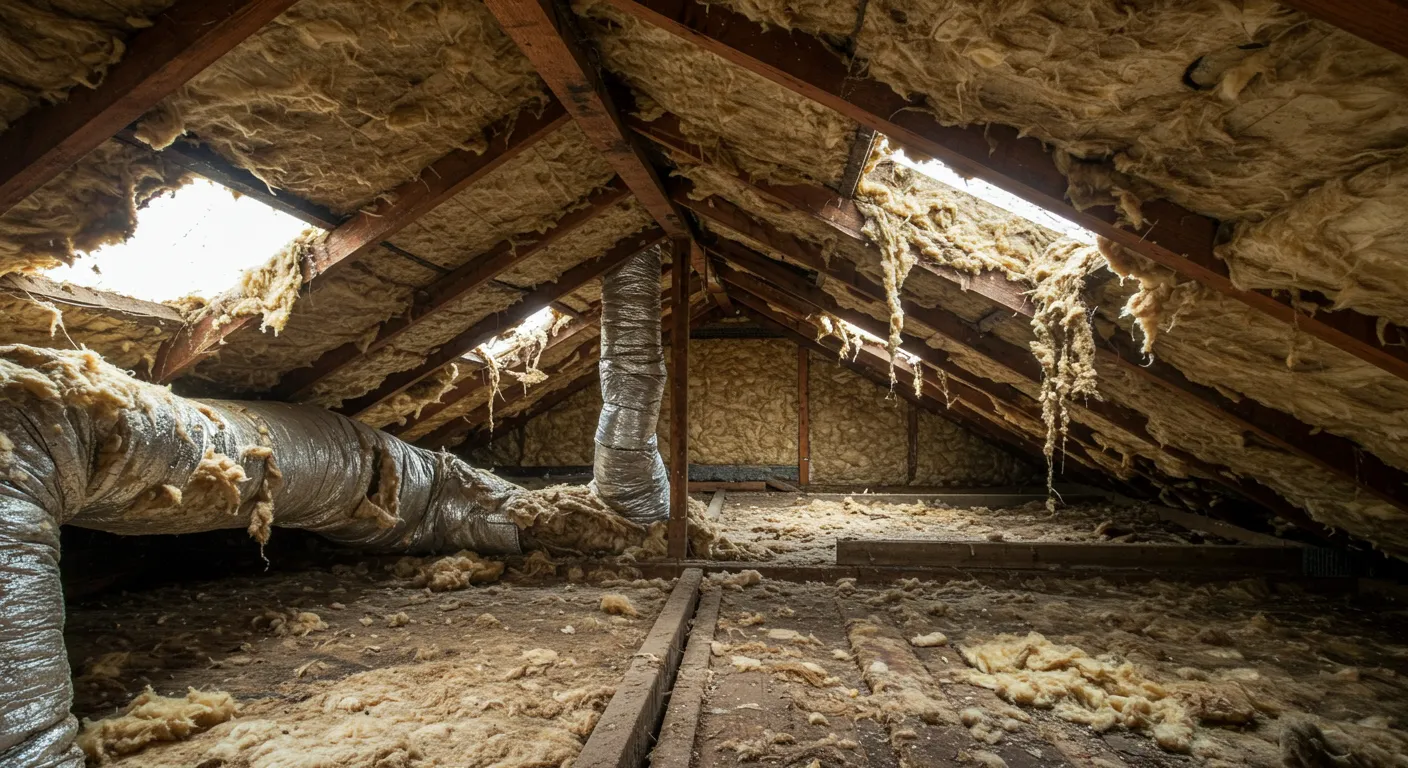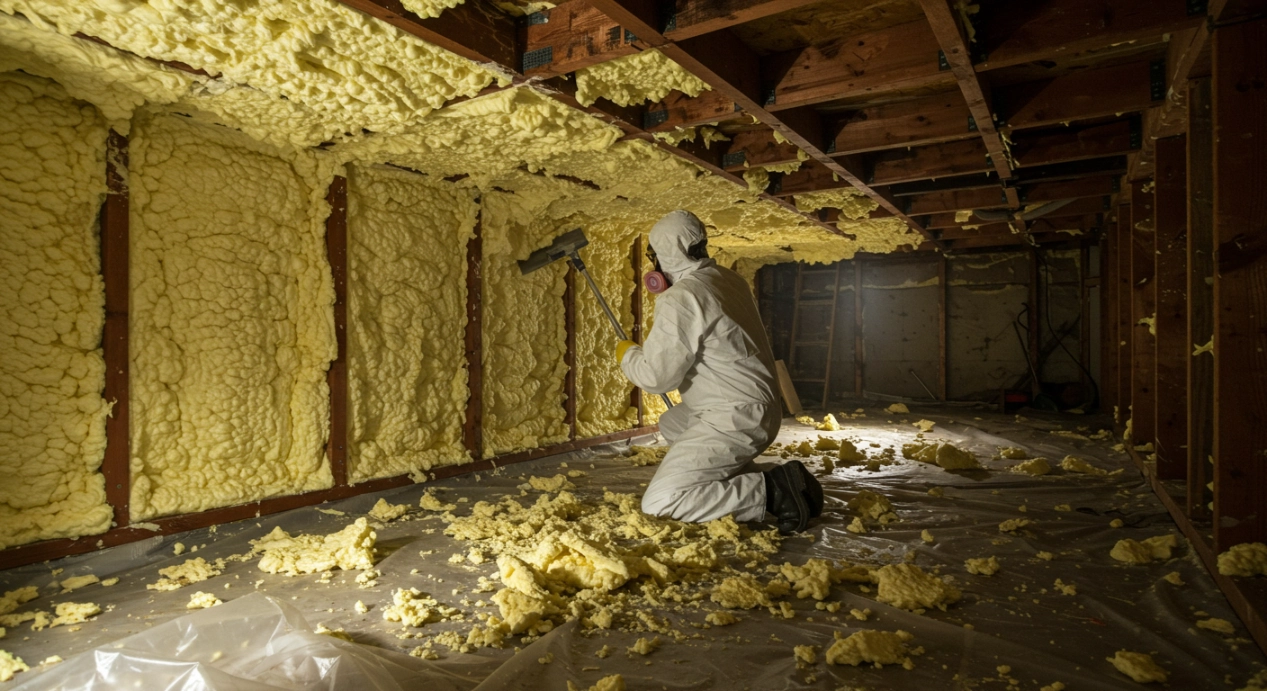Insulation plays a critical role in the energy performance and indoor comfort of any home, but in older homes, outdated or deteriorated materials can become a liability. Whether dealing with vermiculite, moisture damage, pest infestation, or general inefficiency, there are clear signs that it’s time to schedule insulation removal.
This guide helps homeowners and contractors identify the right time for removing insulation in older properties. It outlines technical cues, health and safety risks, and renovation-related factors that affect timing decisions.
Visible Signs That Indicate It’s Time to Remove Insulation
Not all insulation failures are obvious at first glance. But certain visual signs in attics, crawlspaces, and walls often point to deeper problems.
Moisture or Mold Contamination
Older insulation can trap moisture from roof leaks or condensation. Once saturated, it becomes ineffective and promotes mold growth.
- Moldy odors in attic or walls
- Visible dark spots or mildew on fiberglass batts
- Wet or sagging blown-in insulation
Rodent or Pest Infestation
Insulation contaminated by rodents not only loses its insulating properties but also poses health risks.
- Nesting material or droppings
- Chewed or shredded insulation
- Noise in walls or ceiling cavities
Settling and Compression
Some older insulation types settle over time. This reduces R-value and creates uneven coverage.
- Gaps in attic insulation layers
- Insulation no longer level with joists
- Indoor drafts or uneven room temperatures
Health and Safety Triggers for Insulation Removal
In some older homes, insulation removal is more than just an efficiency upgrade—it’s a safety measure.
Asbestos or Vermiculite Concerns
Many homes built before the 1990s used insulation that may contain asbestos or vermiculite. Disturbing these materials without proper handling can release harmful fibers.
- Zonolite vermiculite insulation (often gray, pebble-like)
- Insulation with no labeling or installation records
- Homes built before 1990 with original insulation
Respiratory Irritants
Dusty, degraded, or contaminated insulation can release particulates into indoor air.
- Chronic respiratory issues among occupants
- Dust accumulation near attic access points
- Itchy eyes or throat after HVAC use

Energy Efficiency and Utility Cost Considerations
Insulation performance directly affects how much energy a home needs for heating and cooling. Poor performance in older homes often leads to high energy bills.
Poor Thermal Resistance (Low R-Value)
Older insulation materials have lower R-values than today’s standards. Replacing underperforming insulation can improve efficiency.
- Home doesn’t retain heat in winter
- Air conditioning runs constantly in summer
- Annual utility bills increasing despite no change in usage
HVAC Overcompensation
When insulation fails, heating and cooling systems compensate by running longer.
- Frequent HVAC cycling
- Uneven temperature zones across rooms
- Early wear and tear on heating/cooling systems
When Renovation or Repairs Require Insulation Removal
Remodeling and major system repairs often uncover insulation that needs to be removed or replaced.
Roof Replacements and Structural Repairs
Old attics and roofs often need complete insulation removal to accommodate structural work.
- Exposing joists for roof decking replacement
- Removing insulation for leak inspection
- Replacing water-damaged ceiling components
Electrical and Plumbing Upgrades
Insulation can obstruct access to electrical wiring, plumbing, or ductwork in wall or attic cavities.
- New HVAC runs or duct installation
- Updating knob-and-tube wiring in older homes
- Replacing corroded or leaking pipes
Table: Comparing Insulation Removal Scenarios
| Trigger Event | Urgency Level | Professional Required | Risk Factor |
|---|---|---|---|
| Mold or water damage | High | Yes | Health and structure |
| Asbestos or vermiculite | Critical | Certified abatement | Severe |
| Pest contamination | Moderate | Yes | Health and hygiene |
| Efficiency upgrades | Planned | Optional | Low |
Professional vs. DIY Insulation Removal
While minor fiberglass removal in small attics may seem manageable, many situations call for professional services.
When to Call a Specialist
Trained crews use personal protective equipment, HEPA vacuums, and sealing techniques to safely extract old insulation.
- Suspected asbestos or vermiculite presence
- Mold infestation or biohazard exposure
- Large attic or crawlspace with poor access
DIY Removal Tips and Limitations
If conditions are safe, homeowners might remove insulation themselves with caution.
- Always wear respirators, gloves, and disposable clothing
- Use plastic sheeting to contain debris
- Avoid disturbing materials unless verified non-toxic
Common Questions
How do I know if my old insulation contains asbestos?
Homes built before 1990 may contain asbestos insulation, especially if the material is loose-fill, gray, or pebble-like. Laboratory testing is the safest way to confirm its presence before any disturbance.
Can old insulation be reused if it’s in good condition?
Most removed insulation is not reused due to contamination risks or settling. Even if it looks clean, older insulation rarely meets modern R-value standards and is typically discarded.
Is it necessary to remove insulation before adding more?
In many cases, new insulation can be added on top of existing material. However, removal is recommended if the original insulation is wet, moldy, infested, or compressed beyond usefulness.
How much does professional insulation removal cost?
Costs vary by region, material type, and accessibility. Asbestos-related removal costs significantly more due to safety protocols.
Can insulation removal improve air quality?
Yes. Removing dusty, moldy, or rodent-infested insulation can reduce allergens, particulates, and odors in indoor air—especially in homes with ductwork running through contaminated attic spaces.
Conclusion
Knowing when to schedule insulation removal in old homes depends on several factors: age and type of material, exposure to contaminants, and energy performance. For homeowners trying to reduce energy bills or plan safe renovations, evaluating insulation conditions is a necessary step.
Whether due to health concerns or to meet modern energy standards, insulation removal can offer long-term benefits in comfort, safety, and utility savings. Working with experienced professionals—such as those from a trusted spray foam insulation company offering comprehensive spray foam insulation services—ensures the process is handled safely and effectively.
Reviewer: Maria Lopez reviewed the article and brought 12 years of insulation industry experience to improve the guidance. Practical tips were added, and the content was made clearer and more useful for contractors working in the field every day.
